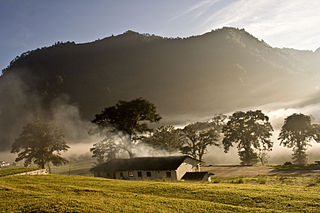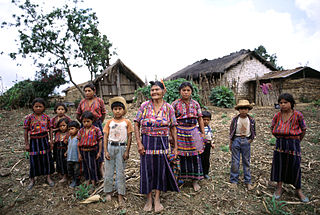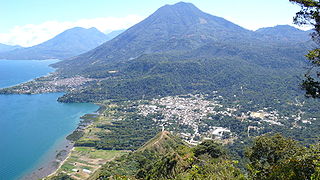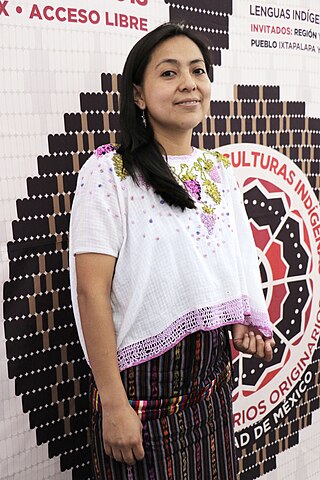Gladys Elizabeth Tzul Tzul (born 1982) is a Maya K'iche' activist, public intellectual, sociologist, and visual artist who was one of the first to study indigenous communal politics and gender relationships in Guatemala.
Contents

Gladys Elizabeth Tzul Tzul (born 1982) is a Maya K'iche' activist, public intellectual, sociologist, and visual artist who was one of the first to study indigenous communal politics and gender relationships in Guatemala.

Tzul Tzul was born in a small K'iche' community in Totonicapán. [1] She is a descendant of Atanasio Tzul , a K'iche' leader who led an indigenous revolution in 1820. [2]
She earned a master's degree from the Alberto Hurtado University in Chile and a PhD in sociology from Benemérita Universidad Autónoma de Puebla in Mexico. [3] [4] Her scholarly work focuses on the relationships of indigenous women within their communities and with larger political structures, such as federal governments. [5] [6] In many of her articles, Tzul Tzul describes how indigenous women resist domination and exploitation through communal democracy in the Andes and Mesoamerica. [7] [6] [8] [9] [10] Indigenous land ownership is also one of her key beliefs. [11] [2]

One of Tzul Tzul's case studies is the Ixcán highland village of Santa María Tzejá, an indigenous community that was destroyed in 1982 as part of the ethnic cleansing of the Maya during the Guatemalan Civil War. [12] [13] [14] As rebuilding efforts began in the 1990s, women in the village linked alcohol to increased violence and began to organize efforts to prohibit the sale of alcohol. [8] Tzul Tzul describes the successful regulation of alcohol starting in 1994 and the accompanying decrease in domestic violence as a success of the "communal process of historical [and indigenous] self-regulation," which could represent the intersectional concerns of indigenous women in a way that federal governance could not. [8]
A key part of her activism is the idea that individual indigenous communities best understand their own needs. [15] [1] She is influenced by the work of Michel Foucault and Silvia Federici, [8] [2] and has argued that indigenous communities can resist political domination through language and through their continued existence. [16] [17]
In 2012, Tzul Tzul faced persecution for her efforts to bring light to the massacre of indigenous leaders; she was an expert witness in the 2016 trials that saw the exoneration of community leaders. [18] [19]
She has written that indigenous communities have responded flexibly to the COVID-19 pandemic despite government neglect because of indigenous authorities' use of native languages and support for communal markets. [20]

She is also the founder of Amaq', an organization that provides legal guidance to indigenous peoples. [3] [21]
In 2017, she received the Berta Cáceres scholarship, named in honor of the Honduran indigenous activist. [4]
Tzul Tzul received the 2018 "Voltaire Prize for Tolerance, International Understanding and Respect for Difference" from the University of Potsdam in Germany. [21]
Tzul Tzul is a member of the indigenous photographers' collective “Con Voz Propia" (English: "In Their Own Voices" or "In Her Own Voice"). [3] The organization was established in response to federal programs to "liberate" indigenous women; instead, Con Voz Propia empowers indigenous women to represent themselves through photography. [1]

This is a demography of the population of Guatemala including population density, ethnicity, education level, health of the populace, economic status, religious affiliations and other aspects of the population.
Kʼicheʼ are indigenous peoples of the Americas and are one of the Maya peoples. The Kʼicheʼ language is a Mesoamerican language in the Mayan language family. The highland Kʼicheʼ states in the pre-Columbian era are associated with the ancient Maya civilization, and reached the peak of their power and influence during the Mayan Postclassic period.

Quiché is a department of Guatemala. It is in the heartland of the Kʼicheʼ (Quiché) people, to the north-west of Guatemala City. The capital is Santa Cruz del Quiché. The word Kʼicheʼ comes from the language of the same name, which means "many trees".

Huehuetenango is one of the 22 departments of Guatemala. It is located in the western highlands and shares the borders with the Mexican state of Chiapas in the north and west; with El Quiché in the east, with Totonicapán, Quetzaltenango and San Marcos in the south. The capital is the city of Huehuetenango.

The Kaqchikel are one of the indigenous Maya peoples of southern Mexico and the midwestern highlands of Guatemala. They constitute Guatemala's third largest Maya group. The name was formerly spelled in various other ways, including Cakchiquel, Kakchiquel, Caqchikel, and Cachiquel.

San Juan La Laguna is a municipality on the southwest shore of Lago de Atitlán, Sololá, Guatemala. It consists of the village named San Juan La Laguna and three smaller aldeas in the nearby mountain. The population is approximately 95% Tz'utujil. Agriculture is most important for the economy, with the service sector growing, especially as the number of tourists increase. The lowest elevation is the shore of Lago Atitlán at 1,562 metres (5,125 ft).

Indigenous peoples of Mexico, Native Mexicans or Mexican Native Americans, are those who are part of communities that trace their roots back to populations and communities that existed in what is now Mexico before the arrival of Europeans.
Luis Enrique Sam Colop or Sam-Colop was a Guatemalan/Native American linguist, lawyer, poet, writer, newspaper columnist, promoter of the K'iche' language, and social activist.
Ricardo Falla-Sánchez is a Guatemalan Jesuit and anthropologist. He studied in the United States and has dedicated his life to documenting the lives and cultures of the Quiché [K'iche'] Maya Indians in Guatemala and other indigenous peoples in Central America. His writings document the massacres of indigenous communities, their struggles for justice and human rights, and their revitalization with assistance by Catholic Action, an outside organization.

Ana María Cofiño Kepfer is a Guatemalan researcher, anthropologist, editor, and historian. She is the founder and co-editor of the feminist magazine La Cuerda and the bookstore El Pensativo. She is a prominent activist in favor of women's rights, gender equality, and the defense of indigenous communities from expropriation by the state and foreign companies.
Julieta Paredes Carvajal is an Aymara Bolivian poet, singer-songwriter, writer, graffiti artist, and decolonial feminist activist. In 2003 she began Mujeres creando comunidad out of the activism of community feminism.

Rita Laura Segato is an Argentine-Brazilian academic, who has been called "one of Latin America's most celebrated feminist anthropologists" and "one of the most lucid feminist thinkers of this era". She is specially known for her research oriented towards gender in indigenous villages and Latin American communities, violence against women and the relationships between gender, racism and colonialism. One of her specialist areas is the study of gender violence.

Aura Lolita Chávez Ixcaquic, known as Lolita, is a women's rights activist and Guatemalan indigenous leader, an international leader in the struggle to preserve natural resources. She was a finalist of the Sakharov Human Rights Prize in 2017 when she was living in the Basque Country in Spain because of death threats in her own country.
The struggle for women's right to vote in Mexico dates back to the nineteenth century, with the right being achieved in 1953.

Thelma Cabrera is an indigenous human rights defender and politician. Cabrera ran for president of Guatemala in 2019 as part of the political party, Movement for the Liberation of Peoples. She finished fourth in the 2019 election garnering 10.3% of the popular vote.

María Jacinta X. Riquiac is a Maya Kʼicheʼ anthropologist and indigenous rights activist from Guatemala.

The Totonicapán Uprising of 1820 was an uprising of indigenous Maya peoples (K'iche') against the Spanish Empire that occurred in Totonicapán, located in the western highlands of Guatemala. The revolt was in response to the excessive tribute demanded by the colonial authorities, and managed to establish a short lived breakaway state in Totonicapán with a free indigenous government. The rebellion was concurrent with the independence of Central America and other Latin American wars of independence.

On the afternoon of 25 September 2021, a group of anonymous feminists intervened in the Christopher Columbus roundabout on Paseo de la Reforma Avenue, Mexico City. On an empty plinth surrounded by protective fences, they installed a wooden antimonumenta, a guerrilla sculpture that calls for justice for the recurrent acts of violence against women in Mexico. It was originally called Antimonumenta Vivas Nos Queremos, subsequently known as Justicia, and depicts a purple woman holding her left arm raised and the word justice carved into a support on the back. Additionally, the Columbus roundabout was also symbolically renamed the Glorieta de las mujeres que luchan.

The Indigenous Documentation Center is an Argentine center specialized in indigenous subjects which compiles, organizes and promotes documental productions generated by authors, cultural models and institutions linked to indigenous peoples. It is located on Pellegrini Street, number 272, in the city of Resistencia, Chaco, Argentina. It is managed together by indigenous and non-indigenous workers from the Institute of Culture of Chaco Province, mostly Wichí, Qom and Moqoit (Mocoví), who plan and execute activities coordinated and conducted by indigenous personnel. Its name ‘No’lhametwet’ is a Wichí term meaning 'place of our word'.
Lorena Cabnal is co-founder of the community-territorial feminist movement in Guatemala and of the Red de Sanadoras Ancestrales del Feminismo Comunitario.